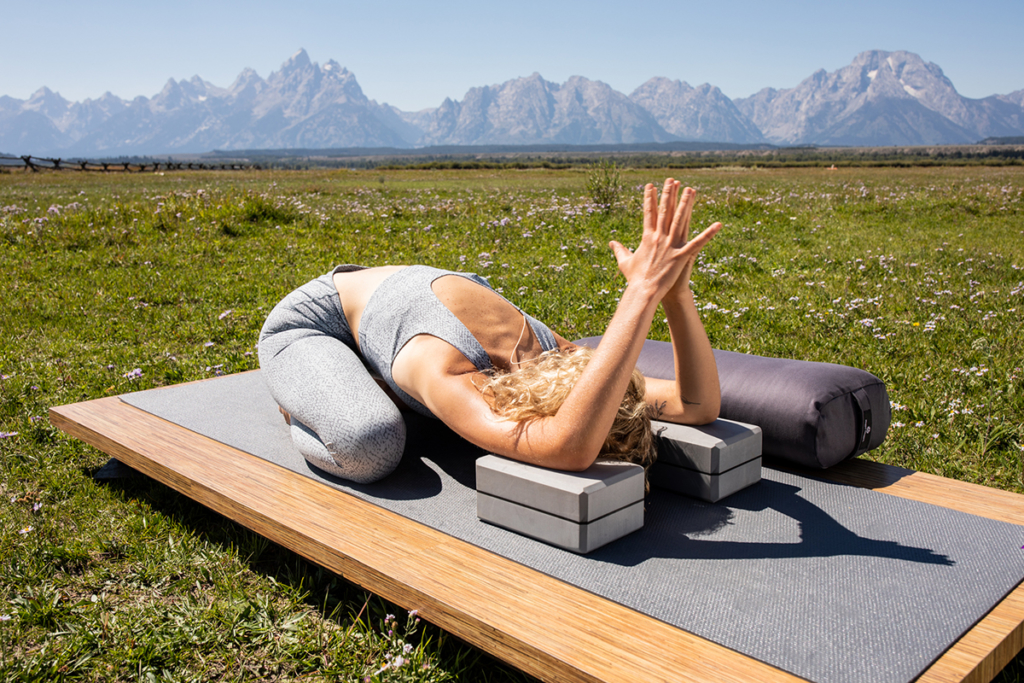
When we think of Balasana (Child’s Pose), we typically think of back expanding, inward folding, and of course, rest. Child’s Pose is an opportunity for respite. We can pause in Balasana during a demanding Vinyasa, or between long holds in upper body strengthening poses. Child’s Pose gives us time to integrate the benefits of previous poses and to collect our minds and bodies for the practice to come.
Balasana is good for us precisely because it feels good. Child’s Pose mirrors the fetal position, the pose of ultimate comfort and security. In Balasana, our back expands and provides a protective shell for our delicate vital organs, which rest in relative calm on our thighs. Resting the forehead on the floor further quiets the mind. The result is a slowing of the breath and brain activity. Child’s Pose is the perfect foil for an active yoga practice and a busy life.
Chest Expansion in Child’s Pose?
Because Child’s Pose is a forward bend, we don’t often associate it with chest expansion. Chest expansion is typically the domain of backbends. But with the addition of a couple Yoga Blocks, we can use the pose to open the chest and armpits passively, and stretch the triceps, even as we enjoy the relaxing benefits of a forward bend.
While there are a few passive chest-expanding backbends—Matsyasana (Supported Fish Pose) and Setu Bandha Sarvangasana (Supported Bridge Pose) among them—much of the time chest and shoulder stretching involves a bit of effort. In Balasana, we can allow gravity, and Yoga Blocks, to do the work for us.
Contraindications for Child’s Pose
Even though Child’s Pose might seem safe and healthy for every body, there are situations in which the pose is contraindicated. If you are experiencing any of the following, you should avoid practicing the pose:
- Knee injuries
- Pregnancy
- Low blood pressure
- Ear or eye infections
- Ankle injuries
- Loose bowels
How to Practice Balasana with Yoga Blocks
- Gather your props: 2 4-inch or bigger Yoga Blocks, a Yoga Mat and a Yoga Blanket (optional, for padding under your knees).
- If you’re using a Yoga Blanket, fold it to a size of approximately 2 by 3 feet. Place it in the center of your mat either lengthwise or widthwise, your preference.
- Place your Yoga Blocks at their lowest or medium height at the head end of your mat. You may need to adjust the distance once you enter the pose.
- Come to Bharmanasana (Tabletop Pose) with your knees on your folded blanket. Make sure your blocks are within reach, right in front of your hands.
- Stretch your hips back toward your heels and simultaneously slide your Yoga Blocks back toward you so that you can rest your elbows on them. Place your palms together and point your fingers toward the sky.
- Let your forehead rest on the floor and allow your chest to soften down toward the floor.
- Breathe into the area around your shoulders, allowing your rib cage to lift up toward the ceiling as you inhale. Let your body settle back toward the floor as you exhale.
- Take 5 to 10 relaxing breaths before lifting your torso up and sitting on your heels. Relax here for a few breaths and repeat the pose if you like.
